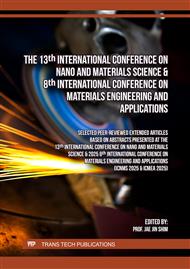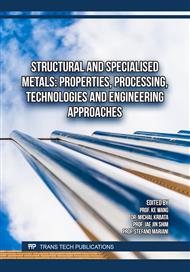[1]
Zhang, X., et al. (2023). "Pressure and polymer selections for solid-state batteries investigated with high-throughput simulations". Cell Reports Physical Science, 4(3).
DOI: 10.1016/j.xcrp.2023.101328
Google Scholar
[2]
Müller, C., Müser, M. H., Carbone, G., Menga, N. (2023). "Significance of elastic coupling for stresses and leakage in frictional contacts". Physical Review Letters, 131(15), 156201.
DOI: 10.1103/physrevlett.131.156201
Google Scholar
[3]
Ceglie, M., Menga, N., Carbone, G. (2022). "The role of interfacial friction on the peeling of thin viscoelastic tapes". Journal of the Mechanics and Physics of Solids, 159, 104706.
DOI: 10.1016/j.jmps.2021.104706
Google Scholar
[4]
Menga, N., & Carbone, G. (2019). "The surface displacements of an elastic half-space subjected to uniform tangential tractions applied on a circular area". European Journal of Mechanics-A/Solids, 73, 137-143.
DOI: 10.1016/j.euromechsol.2018.07.011
Google Scholar
[5]
Menga, N., Putignano, C., Afferrante, L., Carbone, G. (2019). The contact mechanics of coated elastic solids: Effect of coating thickness and stiffness. Tribology Letters, 67, 1-10.
DOI: 10.1007/s11249-019-1137-z
Google Scholar
[6]
Ceglie, M., Menga, N., Carbone, G. (2024). Modelling the non-steady peeling of viscoelastic tapes. International Journal of Mechanical Sciences, 267, 108982.
DOI: 10.1016/j.ijmecsci.2024.108982
Google Scholar
[7]
Afferrante, L., Putignano, C., Menga, N., Carbone, G. (2019). "Friction in rough contacts of linear viscoelastic surfaces with anisotropic statistical properties", European Physical Journal E, 42, 1-8.
DOI: 10.1140/epje/i2019-11844-5
Google Scholar
[8]
Westergaard, H.M. "Bearing pressures and cracks: Bearing pressures through a slightly waved surface or through a nearly flat part of a cylinder, and related problems of cracks." (1939): A49-A53.
DOI: 10.1115/1.4008919
Google Scholar
[9]
Greenwood, J.A., Williamson J.B. "Contact of nominally flat surfaces." Proceedings of the royal society of London. Series A. Mathematical and physical sciences 295.1442 (1966): 300-319.
DOI: 10.1098/rspa.1966.0242
Google Scholar
[10]
Melly, S.K., et al. "A review on material models for isotropic hyperelasticity." International Journal of Mechanical System Dynamics 1.1 (2021): 71-88.
Google Scholar
[11]
Groves, R.B., et al. "An anisotropic, hyperelastic model for skin: experimental measurements, finite element modelling and identification of parameters for human and murine skin." J Mech Behav Biomed Mater 18 (2013): 167-180.
DOI: 10.1016/j.jmbbm.2012.10.021
Google Scholar
[12]
Menga, N., Di Mundo, R., Carbone, G. (2017). "Soft blasting of fluorinated polymers: The easy way to superhydrophobicity". Materials & Design, 121, 414-420.
DOI: 10.1016/j.matdes.2017.02.074
Google Scholar
[13]
Chateauminois, A., and C. Fretigny. "Local friction at a sliding interface between an elastomer and a rigid spherical probe." The European Physical Journal E 27 (2008): 221-227.
DOI: 10.1140/epje/i2008-10376-5
Google Scholar
[14]
Schallamach, A. "How does rubber slide?." Wear 17.4 (1971): 301-312.
DOI: 10.1016/0043-1648(71)90033-0
Google Scholar
[15]
Chaudhury, M. K., Owen, M. J. "Adhesion hysteresis and friction." Langmuir 9.1 (1993): 29-31.
DOI: 10.1021/la00025a009
Google Scholar
[16]
Mandriota, C., Menga, N., Carbone, G. "Adhesive contact mechanics of viscoelastic materials." International Journal of Solids and Structures 290 (2024): 112685.
DOI: 10.1016/j.ijsolstr.2024.112685
Google Scholar
[17]
Mandriota, C., Menga, N., Carbone, G. (2024). "Enhancement of adhesion strength in viscoelastic unsteady contacts". Journal of the Mechanics and Physics of Solids, 192, 105826.
DOI: 10.1016/j.jmps.2024.105826
Google Scholar
[18]
Li, Lei-Tao, et al. "Measurement of real contact area for rough metal surfaces and the distinction of contribution from elasticity and plasticity." Journal of Tribology 143.7 (2021): 071501.
DOI: 10.1115/1.4048728
Google Scholar
[19]
Wriggers, Peter. Computational contact mechanics. Berlin: Springer, 2006.
Google Scholar
[20]
Lengiewicz, Jakub, et al. "Finite deformations govern the anisotropic shear-induced area reduction of soft elastic contacts." Journal of the Mechanics and Physics of Solids 143 (2020): 104056.
DOI: 10.1016/j.jmps.2020.104056
Google Scholar
[21]
Zhang, Da-Wei, et al. "Coulomb, Tresca and Coulomb-Tresca friction models used in analytical analysis for rolling process of external spline." J. Mater Process Technol 292 (2021): 117059.
DOI: 10.1016/j.jmatprotec.2021.117059
Google Scholar



